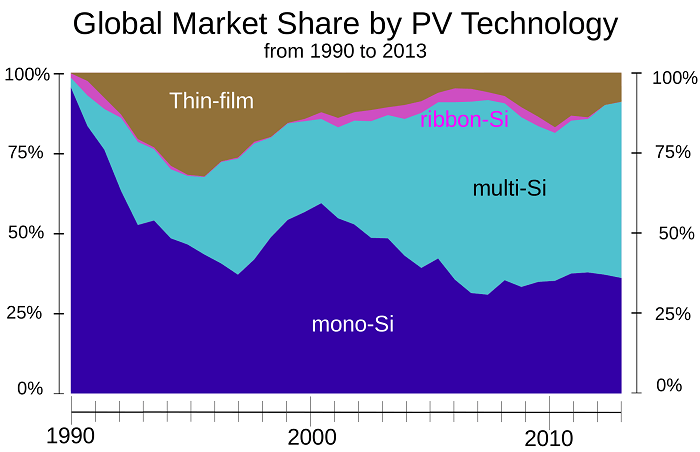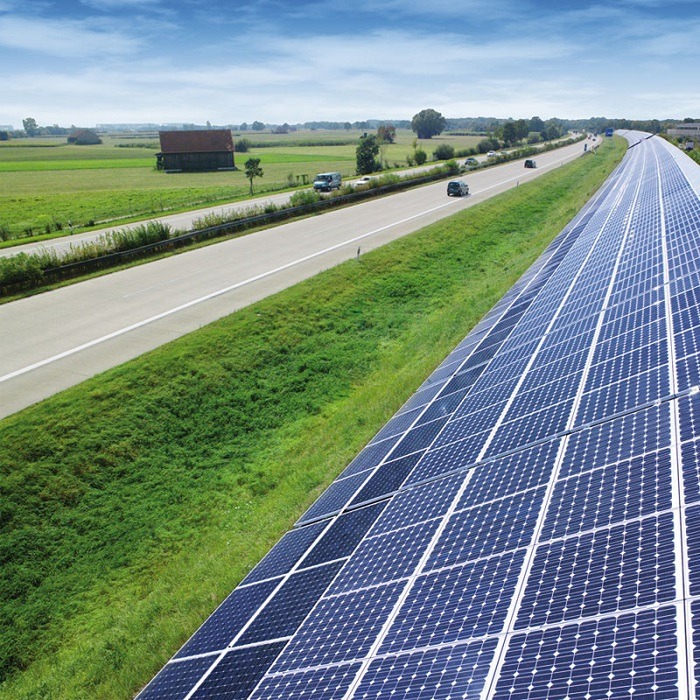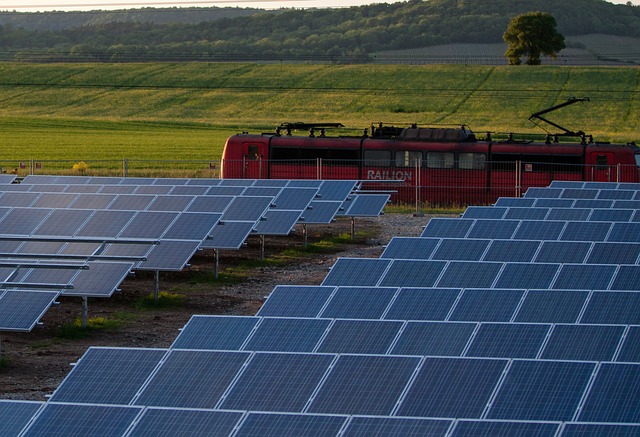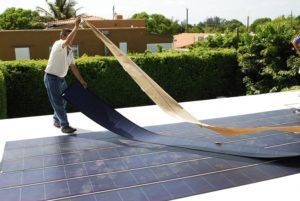There are many types of solar cells on the market today. Technology in this field is constantly changing and developing. With the most recent development of monocrystalline solar cells, the efficiency rates of solar panels have greatly improved, making solar energy a much more viable option, especially for residential use. Polycrystalline panels are now constructed with much more durability than they used to, keeping them in close competition. Let’s take a closer look at these two popular types of solar panels, as they are the most common and best suited for making your home into a sustainable haven.
Monocrystalline vs. Polycrystalline
One is black and the other blue; one is older and the other is new. The differences between mono and polycrystalline panels are greater than just a silly rhyme and color. Taking a closer look, it becomes easier to distinguish the two and assess which one is going to be better for your needs.
Monocrystalline Solar Panels

- More expensive
- 11-22% Efficient
- Made from only the highest-grade of silicon
- Black in color with a rounded look
- Newest solar panel technology
- Long life spans
Advantages of Monocrystalline Panels:
- Efficiency. Monocrystalline silicon is derived by filtering out only the best silicone to use in the individual solar cells. Because of this monocrystalline panels average from 15-20% in terms of power efficiency. The newest advancements are closer to 20% on that scale, meaning that the soak in that much of the sun that hits them.
- Low-light performance- The higher efficiency is why they are able to function better in low-light environments. Many of the panels we recommend on our reviews page have worked fabulously in overcast weather, they just need a little more time to power up.
- Temperature Changes. Monocrystalline panels performance level is less likely to go down when the temperature does (or when it increases). These panels are much more weather tolerant and adapted than their ancestors.
- Lifespan. The majority of them also come backed by warranties stating that they will work at up to 85% of their efficiency measurement up to 25 years after they are installed. That is far beyond the technology that was being produced at the turn of the century.
- Size. Because the cells are made from high-grade silicon only, less is needed, and, therefore, the cells are smaller. This means that the panels themselves take up a lot less space than other panels which ties into their efficiency. It makes them much easier to maneuver and set up.
Disadvantages of Monocrystalline Panels:
- Cost. Since they are the newer technology, monocrystalline panels are typically more expensive in cost. Considering the upgrade in efficiency this cost could easily be justified by the purchaser when looking to get the most for your dollar. Because of this, polycrystalline panels could be better for those looking to spend less. However, we were able to find some amazing monocrystalline and polycrystalline panels that have extremely comparable prices.
- Waste. The process by which the high-grade silicon is filtered from the rest can sometimes mean the excess goes to waste. This is perhaps one of the bigger downfalls of this advanced technology in terms of sustainability.
Polycrystalline Solar Panels

- Cheaper
- 8-15% Efficient
- Multi-crystalline silicon cells
- Blue in color with uniform shaped edged square look
Advantages of Polycrystalline Panels:
- Less Waste. Polycrystalline cells do not require the same filtering as monocrystalline cells. Therefore, all of the initial silicon provided is used which creates less waste.
- Cost. Since there is no filtering process, the creation of these cells takes much less time and resources. This is part of the reason why these panels are cheaper.
Disadvantages of Polycrystalline Panels:
- Efficiency. Polycrystalline panels have a lower average efficiency rate than monocrystalline panels, ranging from 13-16%. This also impacts the price comparatively. If you’re wanting to just experiment with solar panels and want to spend the least amount possible, the lower cost might outweigh the slight drop of efficiency, but for bigger investments this is important to take into consideration.
- Size. The space efficiency, of course, is impacted as well. In order to get as much power from the polycrystalline as monocrystalline, then you’ll need more. They are larger in size because of how large the individual multi-crystalline cells are.
Other Types of Solar Panels
There are a few lesser known types of solar panels.
1. Thin Film (Photovoltaic Cells)
 Thin layers of thin-film silicon onto glass, plastic or metal, and are used more commonly for commercial use on products. It’s a lot cheaper than other types of solar panels, but also a lot less efficient. They are also a lot heavier, but can be applied easily and down flat wherever needed.
Thin layers of thin-film silicon onto glass, plastic or metal, and are used more commonly for commercial use on products. It’s a lot cheaper than other types of solar panels, but also a lot less efficient. They are also a lot heavier, but can be applied easily and down flat wherever needed.
2. Amorphous Solar Cells
Known best as the small solar panels in calculators, they are found in larger appliances as well. They can be stacked on top of each other for better efficiency since they are extremely thin. These cells are about 5-6% efficient.
3. Building-Integrated Photovoltaics
These materials are being integrated into different building parts creating imitation windows, roofs, or skylights. Essentially the building itself becomes made up of solar cells and its own energy source. There are panels shaped like roof tiles and shingles, as well as glass mixtures that can be used as a sort of glaze. It’s more practical for business, due to cost, but if you’re really looking to transform your house into a sustainable home with flashy style, BIPV’s could be the route to take.
4. Copper-Indium-Gallium-Selenide
These cells are about 5-10% efficient. They are larger in size, flexible, and very expensive to manufacture.
Types of Solar Panels: Wrap-up
For more information on solar energy and solar panels check out our solar energy section.



